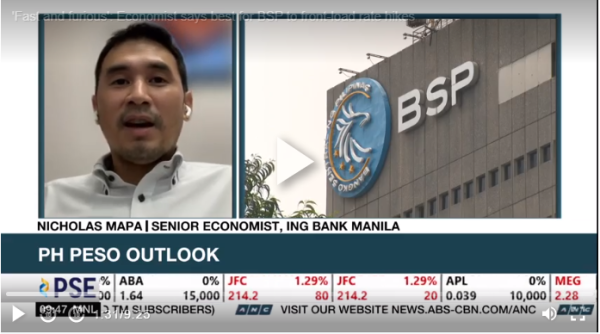[8.18] Fed는 미국의 금리 인상이 더 다가오고 있으며, 속도는 '어느 순간' 느려질 것이라고 말합니다.
컨텐츠 정보
- 17,028 조회
본문
워싱턴 - 미국 중앙은행 총재들은 물가 상승을 진정시키기 위해 금리를 더 인상할 것을 약속하고 있지만, "어느 시점에" 인상 속도를 늦추는 것이 적절할 것이라는 데 동의했다고 연방준비제도이사회가 수요일에 말했습니다.
한은은 40여년 만에 가장 빠른 속도로 급등한 물가를 낮추기 위해 수요를 냉각시키려다 6월과 7월 두 차례에 걸쳐 대규모 3/4포인트 인상하는 등 올해 들어 네 차례 기준차입금리를 인상했습니다.
공격적인 움직임은 미국의 연간 인플레이션이 6월에 9.1%로 치솟은 후 더욱 긴박해졌습니다.
75 베이시스 포인트의 두 번째 대규모 금리 인상을 초래한 7월 정책 회의의 회의록에서 연준 관리들은 "용납할 수 없을 정도로 높은" 인플레이션을 2% 목표 근처로 되돌리려면 시간이 걸릴 것이라고 말했습니다.
정책 입안자들은 세계 최대 경제를 경기 침체로 몰아넣는 것을 피하려고 노력하고 있으며, 회의에 참석한 많은 관리들은 연준이 너무 멀리 갈 수 있는 "위험"이 있다고 경고했습니다.
지난 연준 회의 이후 금융시장은 경기 둔화로 중앙은행이 금리 인상을 철회하거나 중단시킬 수 있다는 희망에 환호하고 있으며, 특히 급격한 인상이 결국 더 정상적인 조치로 자리를 내줄 것임을 시사한 '제롬 파월' 연준 의장의 발언 이후 더욱 그렇습니다.
그러나 연방준비제도이사회(FRB) 관리들은 최근 연설에서 중앙은행이 인플레이션과의 투쟁을 추구할 것임을 강조하면서 과도한 낙관론을 불식시키기 위해 노력했습니다. 이 메시지는 회의록에 메아리쳤습니다.
그리고 경제학자들은 연준의 정책을 결정하는 연방공개시장위원회(FOMC)에서 피벗에 대한 제안을 곧 볼 수 없다고 봅니다.
코로나바이러스 팬데믹이 시작될 때 기준금리가 0으로 인하된 후, 현재 2.25에서 2.5퍼센트 범위에 있습니다.
옥스퍼드 이코노믹스의 '캐시 보스티앙치'는 "FOMC가 9월 21일 금리 인상을 50bps로 축소하기로 결정하더라도 연말까지 연준 자금 금리를 125bps 더 인상할 것으로 기대하고 있다"고 말했습니다.
그리고 중앙 은행가들은 금리가 "충분히 제한적인 수준"에 도달하더라도 인플레이션이 하락하도록 하기 위해 한동안 금리를 유지할 수 있다고 말했습니다.
- 완화될 조짐이 있습니까? -
7월 소비자 물가상승률이 8.5%로 둔화되고 우크라이나 전쟁으로 악화된 치솟는 기름값이 최근 몇 주 동안 하락하면서 경제 데이터에 긍정적인 징후가 몇 가지 있었습니다.
FOMC 위원들은 공급 제약이 완화되었다는 징후뿐만 아니라 최근의 하락에 주목했는데, 이것은 또한 가격을 낮추는 데 작용해야 합니다.
그러나 그들은 유가 하락이 전반적인 인플레이션을 낮추기 위해 "기댈 수 없다"고 말했고, 대신 수요 둔화가 물가 압력을 억제하는 핵심 요인이 될 것이라고 회의록이 말했습니다.
일부 관계자들은 "만족"에 대해 경고했습니다.
그럼에도 불구하고, 중앙은행의 빠르고 공격적인 움직임이 영향을 미치기 시작했고, 관리들은 미국 경제가 하반기에도 계속해서 확장되어야 한다고 말하는 반면, "많은 사람들은 경제 활동의 성장이 추세 이하의 속도로 진행될 것이라고 예상했습니다"라고 회의록이 전했습니다.
노동 시장이 여전히 강세를 보이고 있지만, 많은 사람들은 고용 상황이 완화되기 시작했다는 "일부 잠정적인 징후"에 주목했습니다.
지난 달, 세계에서 가장 큰 경제국은 여전히 노동력에서 모든 실업자에게 거의 두 개의 일자리를 제공했습니다.
한편, 미국 소비자들은 높은 가격에도 불구하고 저축을 끌어모으며 소비를 계속하고 있습니다. 데이터에 따르면 서비스와 자동차 및 기타 대형 티켓 품목에서 벗어나고 주택 담보 대출 금리의 상승이 주택 부문의 활동을 둔화시키기 시작했습니다.
This is the original Article from ABS-CBN NEWS
WASHINGTON - US central bankers remain committed to raising interest rates further to quell rising prices, but agreed it would be appropriate to slow the pace of the hikes "at some point," the Federal Reserve said Wednesday.
The central bank has raised the benchmark borrowing rate four times this year, including two massive three-quarter-point increases in June and July as it tries to cool demand to lower prices that have surged at the fastest pace in more than 40 years.
The aggressive moves took on more urgency after US annual inflation spiked to 9.1 percent in June.
In the minutes of the July policy meeting, which produced a second massive rate increase of 75 basis points, Fed officials said it will take some time to bring "unacceptably high" inflation back down near the two percent goal.
Policymakers are trying to tread a narrow path and avoid pushing the world's largest economy into recession, and many officials at the meeting cautioned that there is a "risk" the Fed could go too far.
Since the last Fed meeting, financial markets have been cheered by hopes that a slowing economy will allow the central bank to dial back or even halt the rate hikes, especially after comments from Fed Chair "Jerome Powell," who signaled that the rapid increases eventually would give way to more normal steps.
But Fed officials have tried to dispel some of that excess optimism, stressing in recent speeches that the central bank is committed to pursuing its battle on inflation -- a message echoed in the minutes.
And economists see no suggestion of a pivot from the Fed's policy-setting Federal Open Market Committee (FOMC) any time soon.
After the benchmark rate was slashed to zero at the start of the coronavirus pandemic, it now sits in a range of 2.25 to 2.5 percent.
"Even if the FOMC decides to scale back its rate hike to 50bps on September 21, we look for another 125bps increase in the fed funds rate by year-end," said "Kathy Bostjancic" of Oxford Economics.
And the central bankers said even when the rates hit a "sufficiently restrictive level," they may keep them there for some time to ensure that inflation falls.
- Signs of easing? -
There have been some positive signs in the economic data, as consumer inflation slowed in July to 8.5 percent, and soaring gas prices, exacerbated by the war in Ukraine, have fallen in recent weeks.
FOMC members noted the recent decline as well as some signs that supply constraints have eased, which also should work to bring down prices.
However, they said falling oil prices "cannot be relied on" to lower overall inflation, and instead, slowing demand will be a key factor in curbing price pressures, the minutes said.
Some officials warned against "complacency."
Still, the rapid, aggressive moves by the central bank have started to have an impact, and while officials say the US economy should continue to expand in the second half of the year, "many expected that growth in economic activity would be at a below-trend pace," the minutes said.
While the labor market remains strong, many noted "some tentative signs" that job conditions have started to soften.
Last month, the world's largest economy still had nearly two job openings for every unemployed person in the labor force.
Meanwhile, American consumers have continued to spend despite high prices, drawing on a stockpile of savings, though data indicate a shift towards services and away from cars and other big-ticket items, while rising mortgage rates have started to slow activity in the housing sector.
관련자료
-
이전
-
다음


